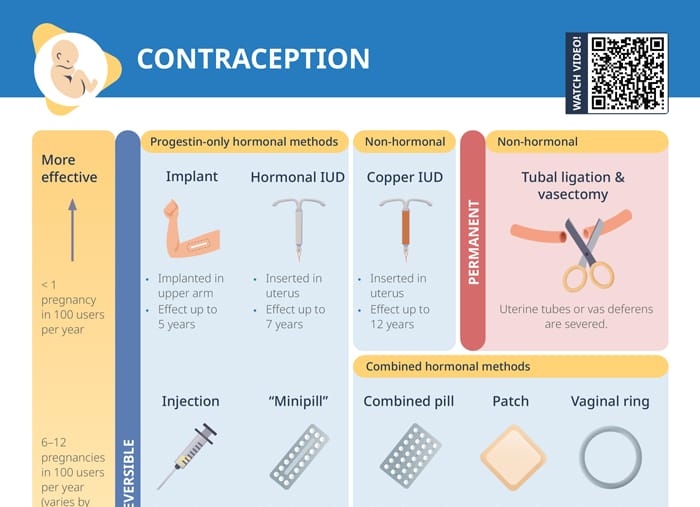How many forms of birth control are there?
Methods of contraception can be roughly categorized as hormonal, barrier methods, intrauterine devices, sterilization, natural methods, and emergency contraception. Each method varies in effectiveness, usage, and suitability for different individuals.
- Hormonal: pills, patches, injections, vaginal rings, implants
- Barrier: condoms, diaphragms, cervical caps, sponges
- IUDs: hormonal or copper
- Natural: fertility awareness
- Emergency methods: pills or copper IUDs after unprotected sex
They could also be categorized into irreversible methods (tubal ligation/vasectomy) and reversible methods (all other methods).
Related videos
Hormonal methods: progestin-only vs combined
Hormonal methods of contraception can be divided into progestin-only methods and combined hormonal methods. Progestin-only contraceptives only contain progestin (the synthetic form of progesterone), while combined contraceptives contain both estrogen and progestin, providing generally more regulation of menstrual cycles and potentially more effective, but problematic for people who cannot take estrogen.
- Progestin-only: mini-pill, injections
- Combined: pill, patch, vaginal ring
Birth control pill
The birth control pill is a medication taken orally to prevent pregnancy. It usually contains synthetic hormones (either a combination of estrogen and progestin or progestin alone for mini-pills) and works by inhibiting ovulation, thickening cervical mucus, and altering the uterine lining to prevent fertilization and implantation.
14% of women aged 15–49 in the United States are currently using the birth control pill. (Data from 2023).
Yaz birth control
Drospirenone and ethinyl estradiol (yaz) is a combined hormonal contraceptive pill containing drospirenone and ethinyl estradiol.
Slynd birth control
Drospirenone (slynd) is a progestin-only pill. Unlike traditional progestin-only pills, it has a 24-hour window for taking late pills.
Sprintec birth control
Norgestimate and ethinyl estradiol (sprintec) is a combined oral contraceptive.
Vienva birth control
Ethinylestradiol/Levonorgestrel (vienva) is another combined oral contraceptive.
Junel birth control
Ethinylestradiol/norethisterone acetate (junel) is a combined hormonal pill.
Mili birth control
Norgestimate and ethinyl estradiol (mili) is a composition of this low-dose combined oral contraceptive pill.
Birth control implant
A contraceptive implant is a small rod inserted into the skin of the upper arm. Over the several years of its use, it continuously releases progestin into the body, preventing ovulation.
Birth control patch
Birth control patches are worn on the skin like band aids and continuously release estrogen and progestin into the bloodstream. They are changed weekly.
Birth control injection
Injections of progestin are another way of hormonal birth control that, other than the pill, does not have to be taken care of by the client themselves daily. Shots are typically given every three months.
Barrier methods of contraception
Outside of tubal ligation/vasectomy and copper IUDs, barrier methods are a popular way of nonhormonal contraception. They include condoms, diaphragms, and cervical caps. Sometimes used in combination with a spermicide, they physically block sperm from entering the uterus.
Condoms are the only contraceptive method that additionally offers protection against STDs.
Natural family planning
For fertility awareness methods to be effective for contraception, training, ongoing monitoring, and abstinence or the use of a barrier method during fertile periods is necessary. Generally, this should be only recommended to clients who don’t need a big focus on the effectiveness or fail-safety of their method of contraception.
What is the most effective method of contraception?
In terms of pregnancies occurring in spite of the use of contraception, the most effective methods of contraception with less than one pregnancy in 100 users per year include:
- Implants (effect up to 5 years)
- Hormonal or copper IUDs (inserted in uterus, effect up to 7–12 years)
- Irreversible methods like tubal ligation and vasectomy (severing of the uterine tubes or vas deferens)
Closely following with 6–12 pregnancies in 100 users per year are:
- Injections
- Mini-pills
- Combined pills
- Patches
- Vaginal rings
The least effective with over 18 pregnancies in 100 users per year are:
- Barrier methods
- Fertility awareness methods
Nursing client education about contraception
- Discuss options for contraception with clients according to their medical history, lifestyle, and personal preferences.
- Explain the effectiveness of different methods as well as backup methods.
- Instruct on correct usage to ensure effectiveness, with a focus on consistency.
- Focus on STD protection as well.
- Advise on the importance of follow-up methods for certain methods, as well as signs of complications.
- Provide information on emergency contraception.

